How to backup a travel trailer (tips, tricks and tools)
We have all seen it and many have done it. Trying time after time to back you RV into a campsite and failing. Getting more and more frustrated with each attempt. I have witnessed husband and wife screaming at each other while blocking other vehicles from traveling down the road.
This is no way to start a camping trip. You are there to relax and enjoy yourself. So, if you struggle with backing your travel trailer or 5th wheel into campsites or your driveway hopefully these tips tricks and helpful tools will get you backing your trailer like a pro in no time.
Get to know your truck and trailer
To master backing your travel trailer the first step is to know how your truck and trailer work together.
There are many things that can affect how your trailer will respond when backing up. Every truck and trailer combination will act a little bit different. Here is list of some of the things that have an effect on backing your trailer.
- Distance between front and back wheels of your truck
- Distance from back wheels of your truck to the hitch
- Distance from the hitch to the trailer axle
- Number of trailer axles
- Turning radius of your truck
Now, as an engineer, I’m sure there is a scientific way to calculate exactly what you need to do to perfectly back any trailer combination. But, in the real world you don’t need physics and trigonometry to back a trailer. All you need is some practice and some basic principles.
Getting the right view (adjusting your mirrors for towing)
The first step is being able to see your trailer and what is around you. You probably already know that the little mirror stuck to your windshield is useless when your RV hitched up. This makes adjusting your side mirrors even more important. While having a backup camera on your RV is great for seeing behind your RV (more about those later) they aren’t necessary to get it right on your first try.
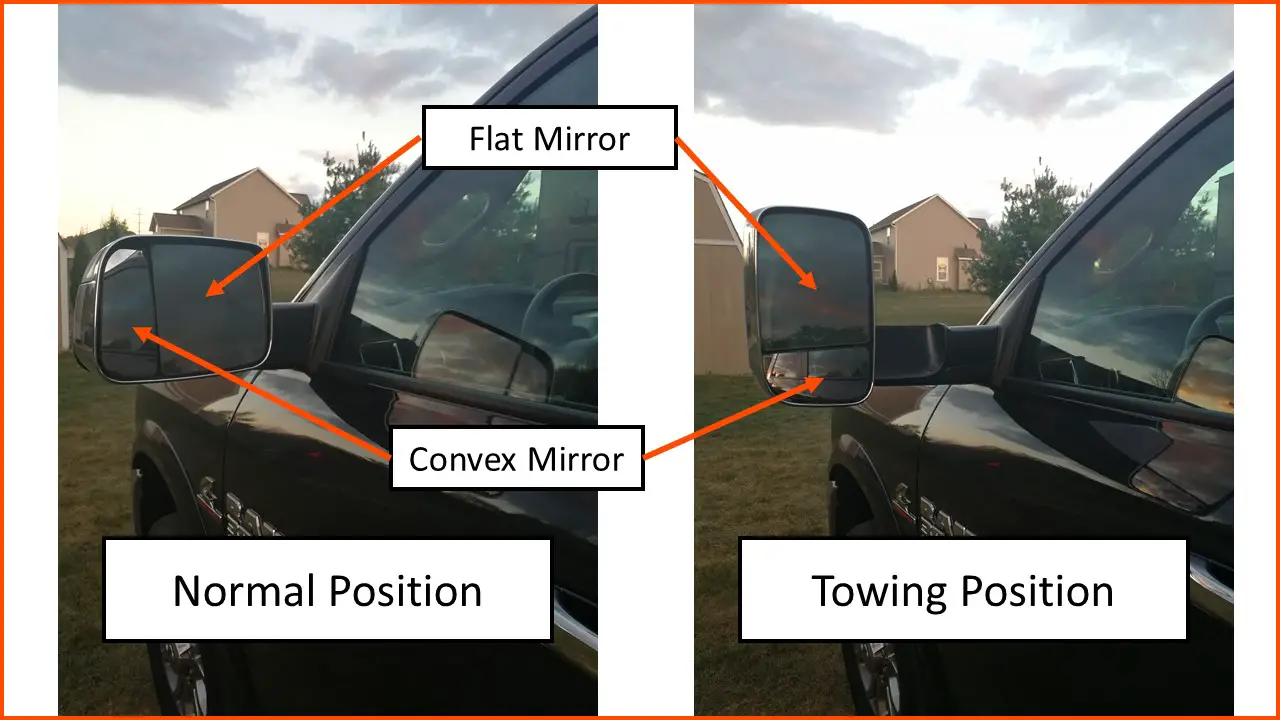
The mirrors on your truck are probably split into 2 separate mirrors. A flat mirror and a curved mirror (convex mirror). These mirrors serve different purposes and are both crucial to seeing what is behind and around your camper.
- Flat mirror – The purpose of the flat mirror is to give you an accurate view of what is behind and beside you. The flat mirror shows distance accurately, but doesn’t have a very wide view.
- Convex mirror- The purpose of this mirror is to give you a wider view and cover your blind spot. The downside is because of the shape of the mirror it is hard to judge distance.
Steps to adjusting your mirrors
- If your mirrors flip up or telescope out move them to the towing position
- Flat mirror adjustment
- Adjust left-right so you can see all the way down the length of your RV to the back corner. You want to see the trailer along the edge of the mirror. Most of your view should be the lane beside your RV.
- Adjust up-down to see the road at the back corner of your travel trailer. If ½ or more of your mirror is showing the sky adjust your mirror down lower.
- Convex mirror adjustment
- Adjust left-right so that you can see your trailer on the 1/3 of the mirror closed to the vehicle.
- Adjust up-down so you can see the road along the side of the RV.
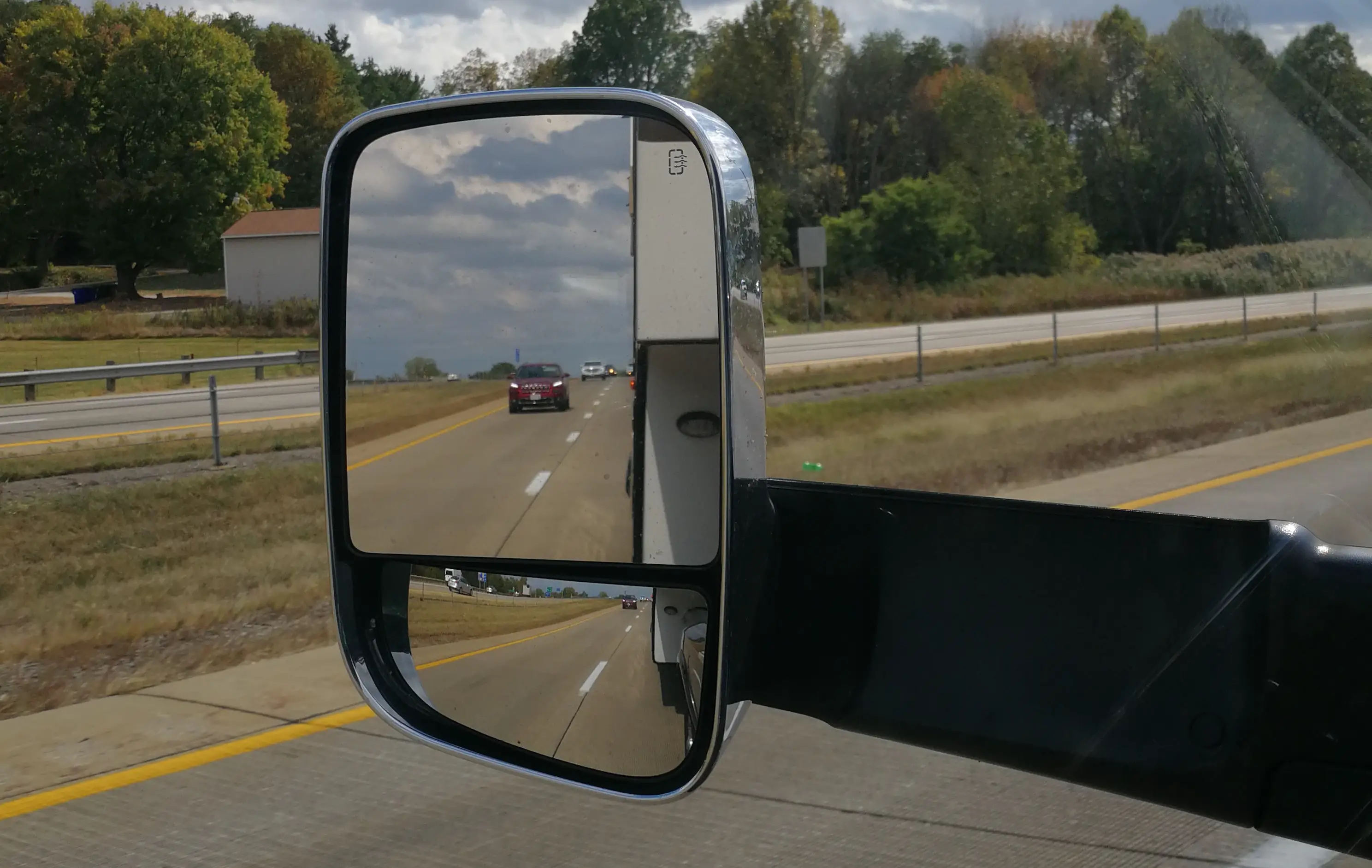
Finding a place to experiment
When I purchased my current RV I also made the change from a travel trailer to a 5th wheel. I wasn’t sure how sharp I was going to be able to turn with my new Andersen Ultimate fifth wheel hitch in a short bed truck (BTW, I love that hitch).
My first trip from home was to a boat launch at a nearby lake. I went on a weekday evening when I knew the large parking lot would be mostly empty. This gave me a chance to really get a feel for how my trailer would respond and what it’s limits were.
Practice
If you take some time to think about it, I’m sure there is a large parking lot near you too. I took a friend with me to act as a spotter when I went to the boat launch.
- First, I just spent some time making left and right turns with the wheel cut as far as it would go to see if the trailer would jackknife going forward.
- Next, I tried the same in reverse both to the left and right. Of course, my spotter was watching closely to make sure I didn’t crash the trailer into the back window of my truck.
- Finally, after learning the limits of the combination I practiced backing the trailer into a parking spot several times.
This trip taught me several things about my truck/trailer combination. I learned that even driving forward I could get the trailer dangerously close to the cab of the truck. I also learned that I could safely get the trailer almost 90 degrees to the truck. Lastly, I learned that I need to pull further forward than I initially thought when setting up to back into a parking spot.
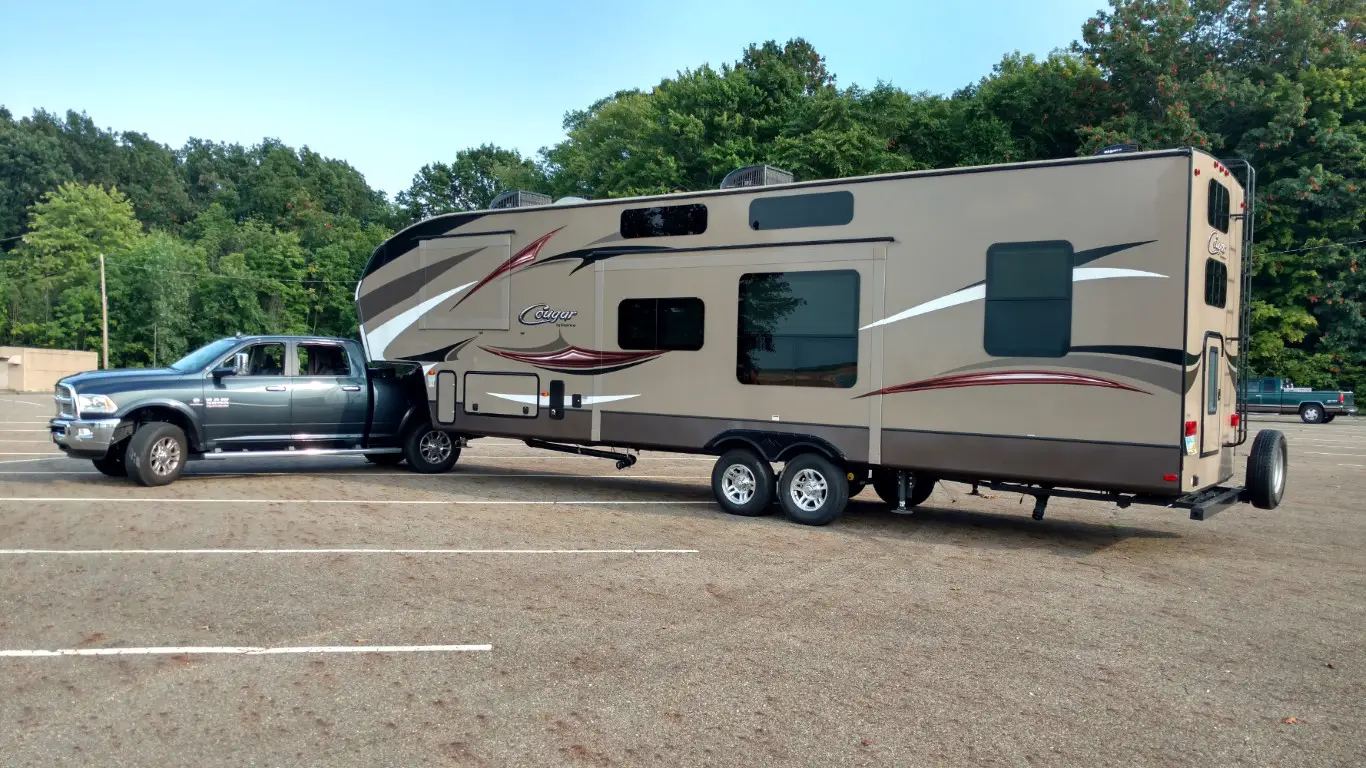
All of these lessons could have been learned on the road or at the campground. By taking an hour to find a parking lot to practice in I was able to learn faster and safer than learning on the road. As an added bonus I didn’t have to make my first attempt at backing the 37 foot fifth wheel in a campground with the neighbors watching.
5 Free Checklists
Enter you email below for access to 5 free checklists for you next trip.
Some basic tips
Before I get to the step by step instructions here are some basic tips for how to backup a travel trailer into a campsite or driveway. Following these tips will make backing your RV easier and could save your marriage.
Use a spotter
Using a spotter is probably the most important tip to safely and effectively back you trailer into a campsite. With children running around and trees near the parking pad it is almost impossible for your to be aware of everything around you. Having an extra set of eyes helping to guide you into your site is invaluable. Here are a few tips for you and your spotter.
- Work out a system of hand signals so you don’t have to yell back and forth. You only need a few signals, left, right, back and stop should be enough.
- Make sure you know what left and right mean is it the front or back of the trailer? My wife always tells me the direction she wants me to move the back of the trailer.
- Make sure your spotter knows where to stand so that you can see them. If my wife moves out of my view while I am backing I simply stop. If this happens she knows I can’t see her and she will move. Let you spotter know that if they can’t see you in the mirror, you can’t see them.
- Before backing in talk about where you want to end up. This way you are both trying to get to the same place.
- DON’T YELL AT YOUR SPOTTER!!! This should have been the first tip. No matter how many times you have to pull forward and try again stay calm.
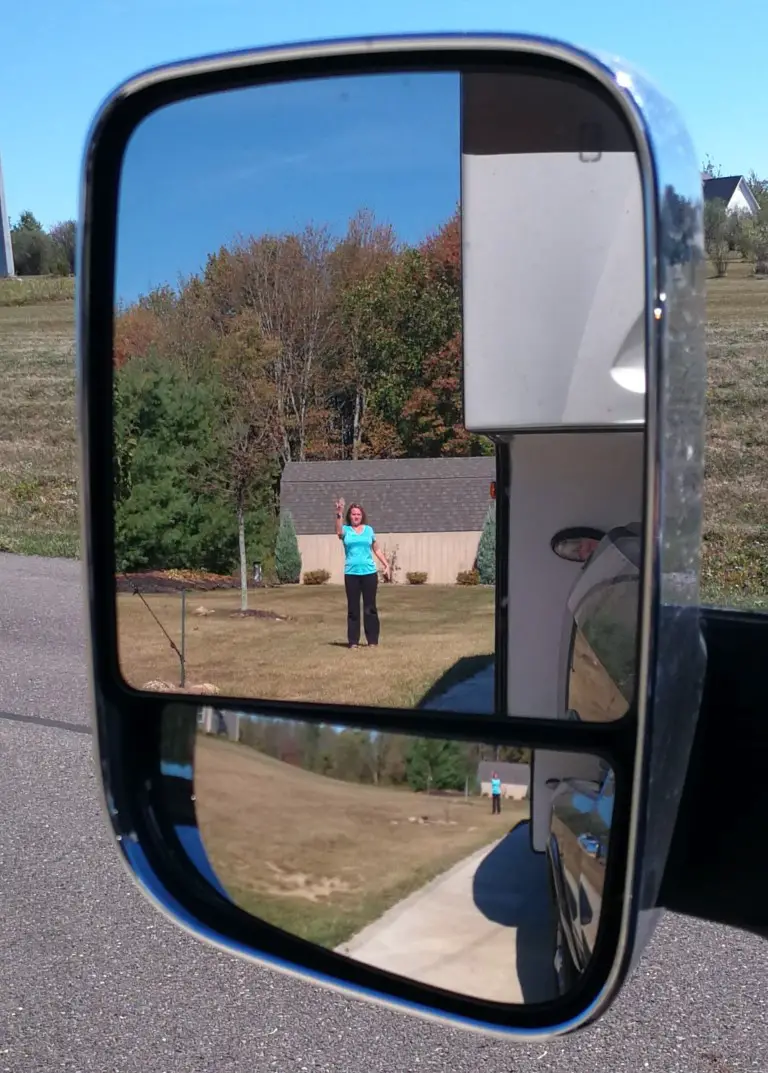
Let the children out
If you travel with children one of two things probably happens when you arrive. Either they are asleep from the ride, or they are stir-crazy in the back seat. If your children are restless and old enough to be on their own for a few minutes, let them out. I will send mine to the playground or to the back of the site. They know to stay out of the way of the RV. It is much easier to concentrate on backing in when they aren’t in the back seat driving me crazy.
Don’t be afraid to try again (and again, and again….)
Don’t be ashamed to pull forward and try again! Sometimes you will need to pull forward to get a better angle to back in. In some cases, there may be trees or other obstacles in your way that even the best driver can’t get around in one attempt.
If you’re not sure stop and get out
Even with a spotter there are sometimes that you just aren’t sure. If you aren’t 100% sure with what you are doing put it in park and get out. Would you rather take a few extra minutes to back in, or spend you trip wondering how much the repair is going to cost for hitting that tree or power post.
Once you’re in it’s not over
After you get backed into your camp site don’t jump out and unhitch right away. Walk around your RV and make sure you can setup. I unhitched, leveled, hooked up my shore cable and was putting my slide out a few weeks ago and realized the slide was going to hit the power post. A quick walk around before unhitching would have saved 15 minutes of getting hitched back up to move the camper over about a foot. Here are a few things to check
- Are all slide out rooms clear of trees, and utility posts?
- Will you shore power, water and sewer connections reach?
- Are there any trees or other obstacles in the way of extending your awning?
- Will moving forward or backward put you on more level ground making it easier to level your RV and extend your stabilizer jacks?
6 o’clock rule
If you have trouble knowing which way to turn the wheel when backing up this tip will help. Place your hand at the bottom of the steering wheel. If you move your hand to the left the back of the trailer will move left. If you move you hand to the right the back of the trailer will move right.
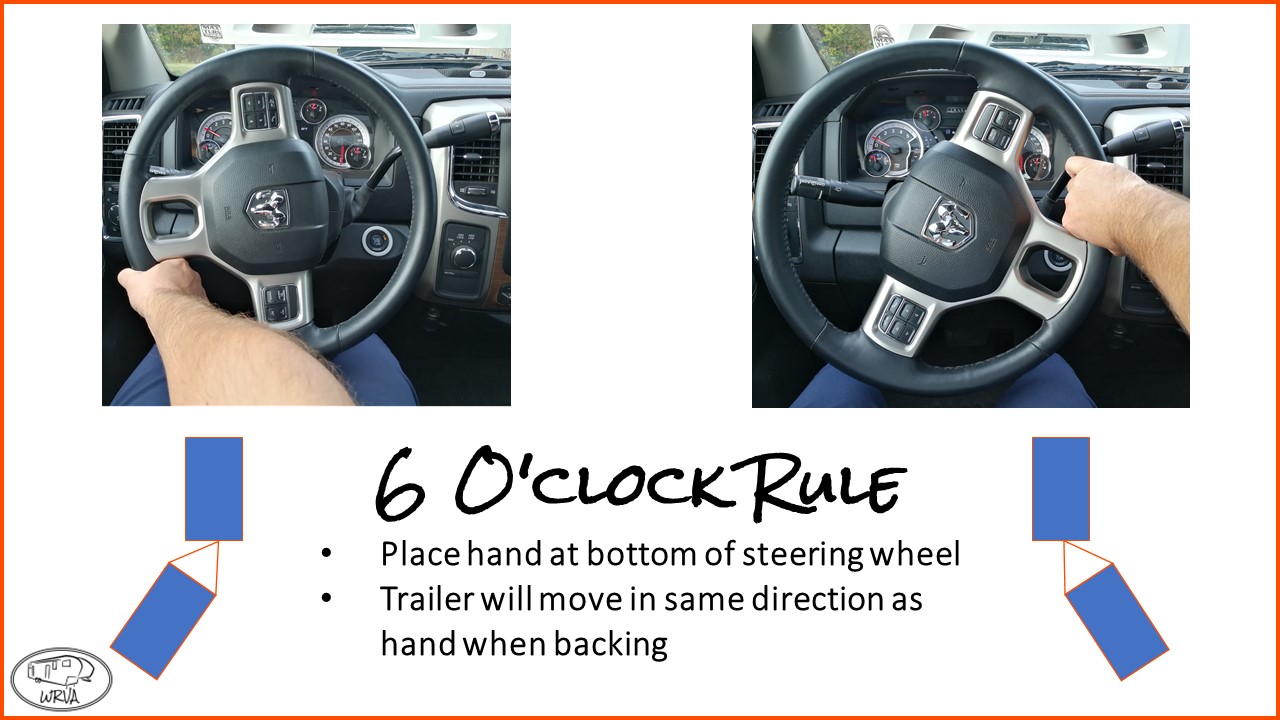
Imaginary line
Another trick to help you back in is to draw and imaginary curve from where your trailer’s tires are to where you want them to end up. While you are backing up try to keep the tires on that imaginary line all the way to your parking spot.
Long and slow, or short and fast?
If you have a long RV it will be slow to react. When you back up this means you need to make bigger corrections and it will take longer to straighten back out. If you have a shorter RV it will react much quicker when backing. You should make smaller corrections and be ready to straighten out sooner. In my opinion longer trailers are easier to back than shorter ones.
Step by step: How to back your RV into a campsite
Now for the fun part. Your mirrors are adjusted, you know all the tips. Let’s get that camper into your site and enjoy your weekend adventure.
Step 1: The approach
The first step to successfully backup your travel trailer is to have the right approach to your site. This means getting as close as possible to the side of the road your site is on. By getting close to the edge you will have more room when you make the cut.
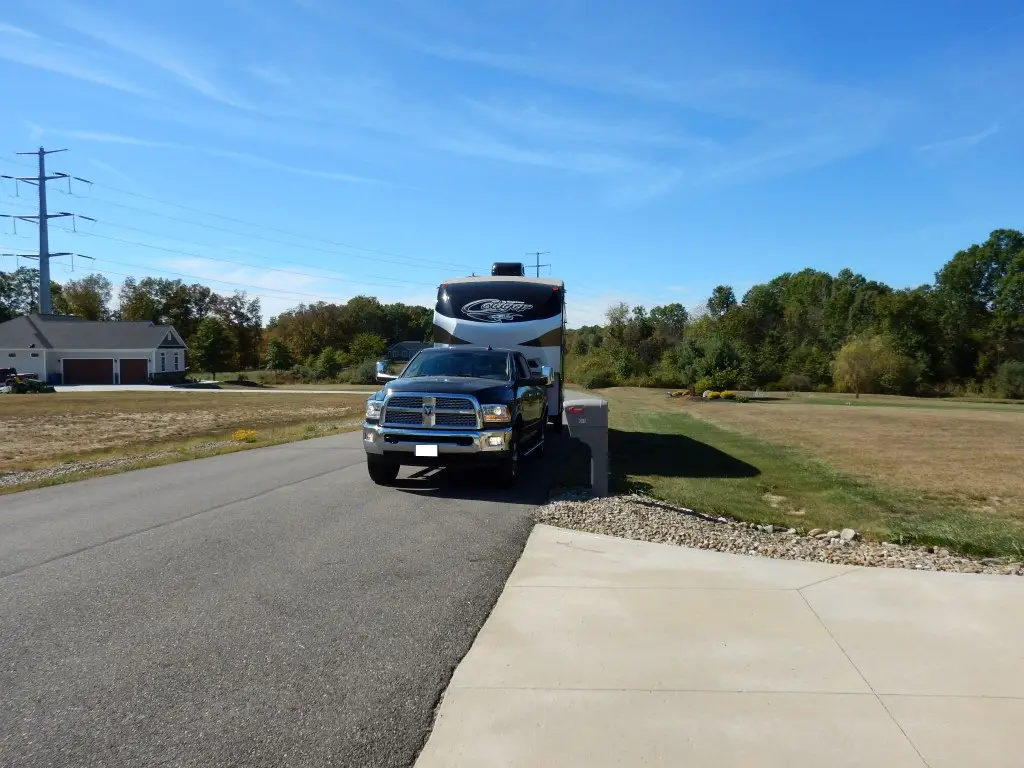
Step 2: The drive by
Now you should drive past the site stopping with the rear bumper of your RV just past the pad or driveway. This step is where knowing how your trailer responds comes into play. Some trailers may need to pull a little farther forward, some back a little bit. Practice is the only way to know for sure where you need to be.
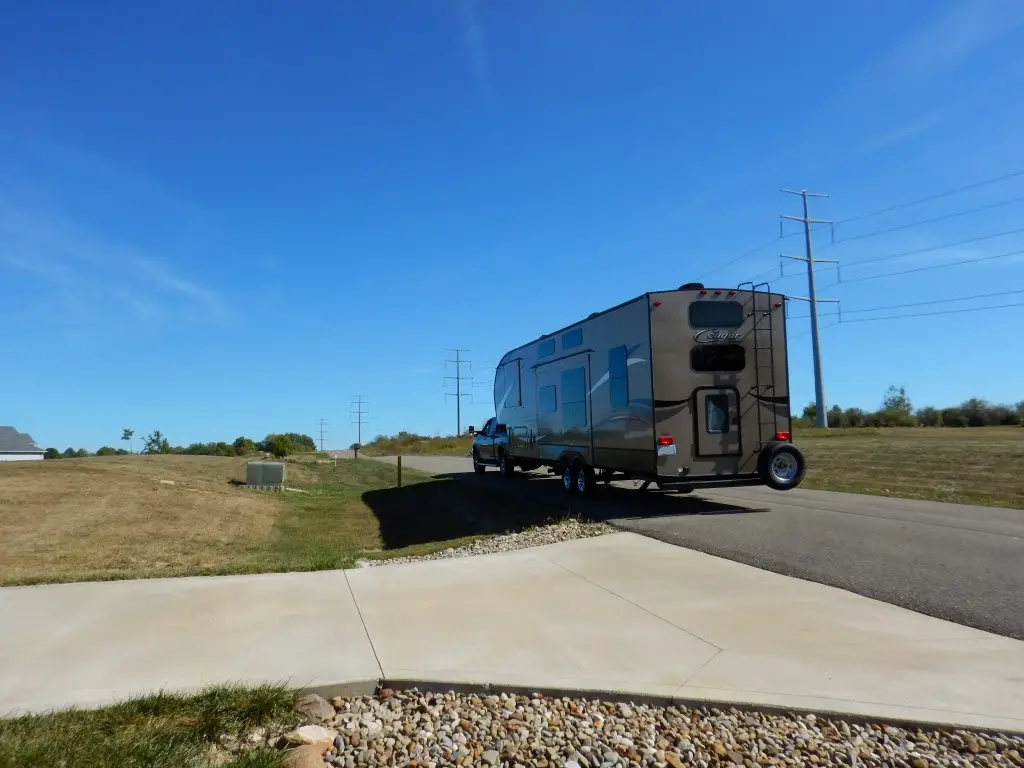
Step 3: The cut
We are ready to put it in reverse. At this point you need to cut the wheel as far as possible to the opposite side of the road from your site. This will start the trailer swinging into the site and your tow vehicle will be moving across the road.
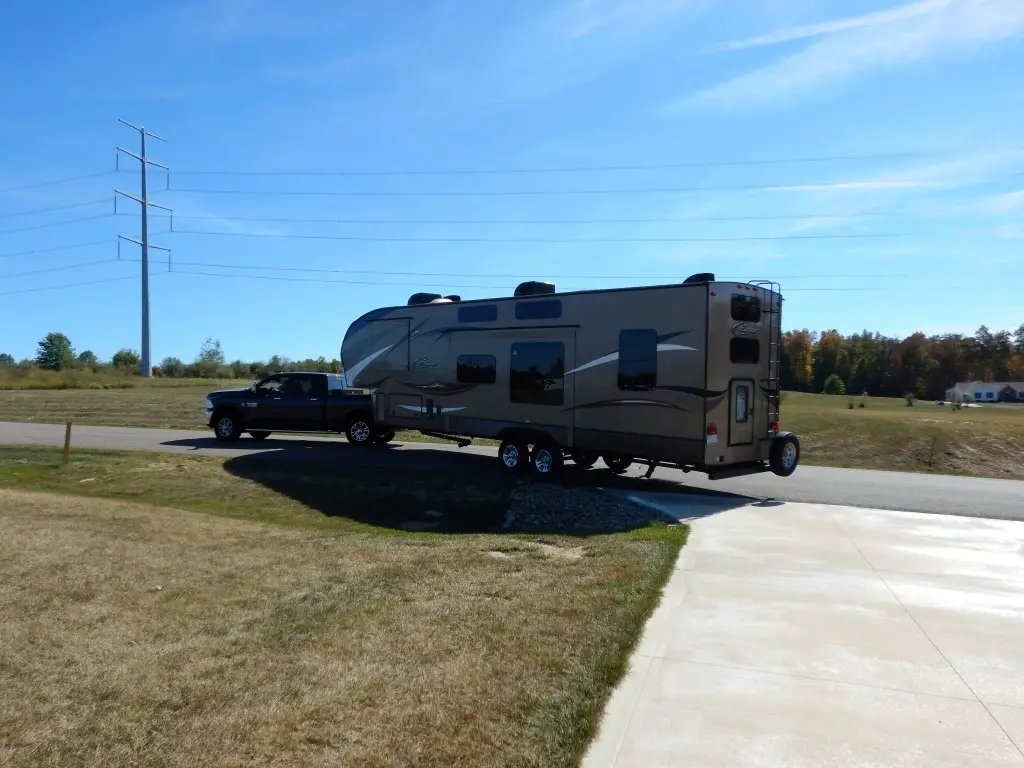
Step 4: The S-turn
Once the trailer is swinging into the site you are almost there. All that is left is to start turning the wheel back towards your site to follow the trailer around and straighten everything back out.
This is also the point where you are most likely to run into a problem.
- If you start turning back too early you will end up on the far side of the pad.
- If you start turning back too late you could jack-knife or end up on the near side of the pad.
If you aren’t happy with your position this is the time to pull forward, straighten things out a little bit and try again.
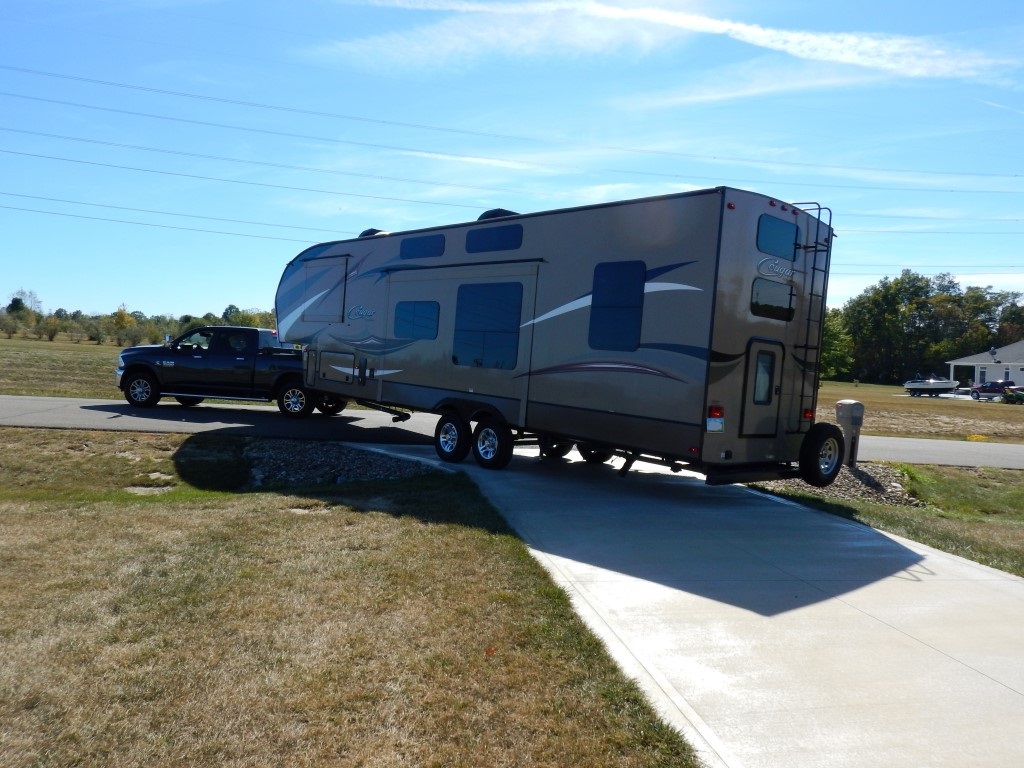
Step 5: Guiding it in
In the last step you just have to line the trailer up the way you want. This is where the 6 O’clock rule can come in handy. Again, if you aren’t happy with your position pull forward and make an adjustment.
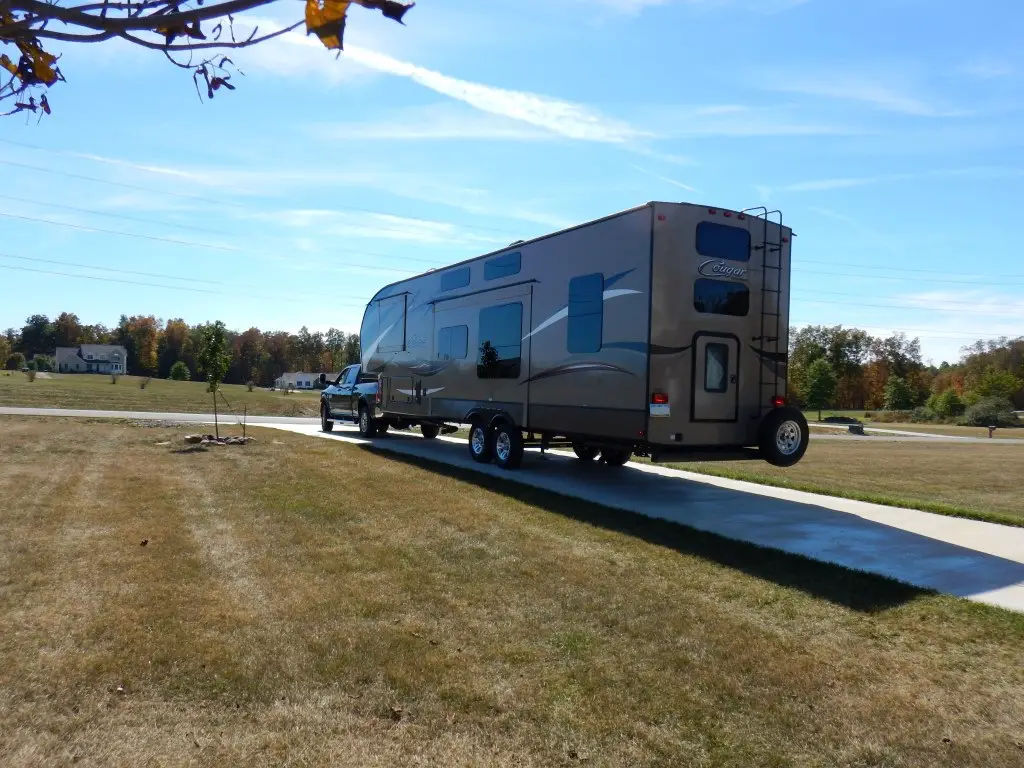
Backing Video
If you still aren’t sure checkout this video for more tips on backing your travel trailer.
Gadgets and tools to help you backup
If you’re like me (and most men are) you like gadgets. Here are a few gadgets and tools that can make your life even easier when backing a trailer. They are range from simple to high tech, but all of them can be a great help.
Rope
I know, how can a piece of rope help you back your RV right? The rope takes the imaginary line tip one step further and gives you an actual line to follow. I have tried this when parking my 5th wheel beside my barn and it does help. Simply take a piece of rope and lay it out along the path you want your RV’s wheels to follow. As long as you keep the wheels on the rope while backing up your trailer will end up exactly where you want it.
If you want a rope you can even see at night this reflective, glow-in-the-dark Guyline on Amazon will help guide you day or night.
2-way radios
Use a set of short range radios so you can easily communicate with your spotter. If hand signals aren’t working out. Or if you just have a hard time seeing your spotter in the mirrors this is a great solution. The radios also come in handy for communicating around the campground, or when hiking. Especially when you don’t have good cell phone coverage.
This set of Motorola radios advertise a 23 mile range don’t expect to get that in the real world, but this set is great to use when backing your RV and when hiking. The set comes with 2 radios with belt clips, batteries and a dual charger that can keep both radios charged and ready to go.
RV backup cameras
If you are looking for the safest way to back you trailer especially if you won’t always have a spotter an RV backup camera is the way to go. There are many great options out there like this TadiBrothers wireless system available on Amazon.
If you want more information on RV backup cameras checkout my comparison of the best wireless rear view cameras for travel trailers.
Wrap-up
Backing your camper doesn’t have to be a nerve racking experience. With A little practice, and by following the tips and steps above, pretty soon you will look like a pro when pulling into the campground.
If you have your own tips for backing a travel trailer please share them by leaving a comment below.
Also, if you found this helpful please use the buttons below to share on Pinterest or Facebook.
Thanks and enjoy your next weekend RV adventure.
Share this Post

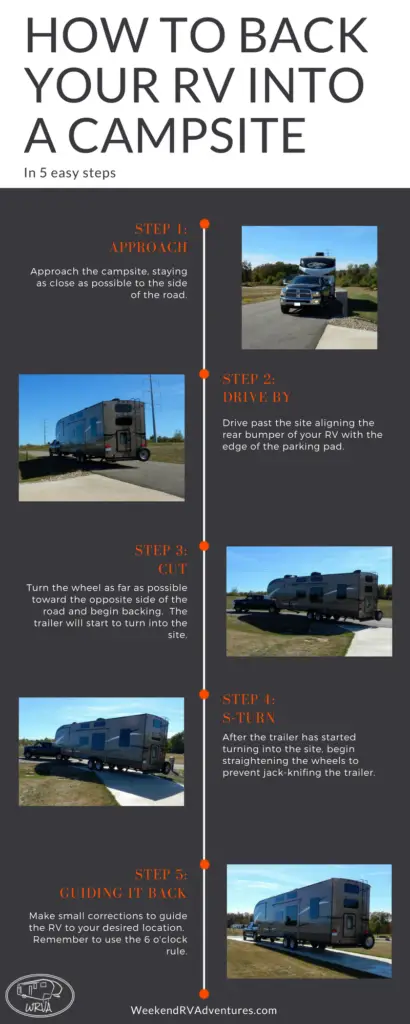



This is some really good information about RV parking. My father has been thinking about getting an RV this summer. I liked that you pointed out that walkie-talkies could be a useful thing to help you park your RV. That does seem like something I should tell my father since he likes to camp in areas that get poor cell phone reception.
Ivy, thank you for the compliment. I know I have camped in many locations where my cell phone wouldn’t work.
Jason
Thank you for doing this! I’m positive people have considered divorce from so many failed attempts at backing up their travel trailer. My husbands anxiety level soars with the mere idea of having to complete the task. More often than not, I’m put behind the wheel trying to make sense of his hand gestures and shouts. I would be lying if I told you I didn’t want to run him over! 🤷🏼♀️ I’ve shared all of these tips with him, take screenshots, and we have a plan. The only thing left to do, is practice until we have mastered it!
Thanks!
Joanna
Joanna,
Thanks for your comment, I enjoyed reading it!
I hope some of these tips help you out.
Jason
Very informative. I never thought about using cell phones to communicate with the spotter. At the age of 63 I finally bought our first travel trailer and I realized driving it home I would need lots of practice to get confident in backing it up. These tips will come in handy for our first trip in June 2018. Thanks!
Gary,
It’s great to hear that your finally got a travel trailer, I’m sure you will love it. Don’t be afraid to ask questions, either here or your neighbors at the campground. Most campers are very friendly and love to help out. Thanks for the comment.
Jason
Great tips, I too, just bought a new travel trailer(20ft), backing up has been a bit stressful. I find myself only picking camp sites that I can just pull in. However, I feel like I am missing out on truly being in the ‘woods.’ I will definitely be practing more at my local Target!!
I’m sure with a little practice you will get the hang of it. If you can take your spotter with you to improve your “team work”.
Thanks, Jason
Jason,
You are awesome and very kind to share your knowledge, especially with the old broad who is new to camping. Just bought and refurbished a 15′ StarCraft. Any tips on making sure it is hitched up correctly? I am really nervous about that. How can I make sure I have it hitched to my SUV correctly, with no mistakes/accidents?
Dawn,
Thanks for the compliment, the biggest tip I have to make sure everything is hitch correctly is to make sure you do a final walk around before getting in the driver’s seat.
When you are in a rush to get going it’s easy to miss something like, plugging in the power or removing a wheel chock.
Right before you leave just take a minute or two and walk all the way around your rig checking above, below and around everything. If you do that every time you will be much less likely to forget something.
Thanks again,
Jason
What is the 6 o’clock rule?
If you place you hand at the 6 O’Clock position on the steering wheel (the bottom) the trailer will move the direction you move your hand. So if you want the trailer to turn left move your hand to the left.
There is an image showing how the rule works, Try reloading the page if you can’t see it.
Thanks,
Jason
Pingback: 24 Of The Best Camping Blogs That You Should Be Following - Beyond The Tent
You put together a great list of camping blogs and I’m honored to be on there. I am going to start following some of your other recommendations.
Thanks,
Jason
Great information however don’t understand how to use the rope for imaginary line….how can you even see it?
Also we use our Durango to pull our 30’ travel trailer – do you have any recommendations as to type of extended mirrors we need for driver & passenger side?
Thank you
Lynda,
For the imaginary line, just picture the path you want the tires to take and try and follow it. When using a rope, you may have to adjust your mirrors down a little bit and then as you are backing up keep the tires right on or next to the rope you laid out.
For the mirrors, I like the ones that look like the match the vehicle. CIPA makes some nice ones. You didn’t mention the year of your Durango, but this pair will fit a 1998-2004.
Thanks,
Jason
Thanks for the great tips! I just went from a 37’ class A to a 36’ 5th wheel with a dually. Talk about a HUGE learning curve! I get anxious just thinking about backing (even after practicing!). I love your point about not yelling at your spotter-I think the fellow campers at our current site thought I was going to leave my S/O at the campground! What are your thoughts on maneuvering on really tight, narrow and curving roads in campgrounds? I’ve nearly taken out a various trees and shrubs along the way. Thanks again for all of the info!!!
Scott,
I think my wife has thought about leaving me at a camp site a couple times 🙂
I don’t have a silver bullet for you on that one. My best suggestion is try to keep an eye out on whats coming up and maneuver to give you the best opportunity to avoid it.
Don’t be afraid to use a spotter while getting around the campground too.
Thanks,
Jason
If there is a choice… and all obstacles being equal… is it easier to back into a site on your driver’s side or passenger side?
Tracy,
All things be equal, I prefer to back in to the driver’s side.
That allows me to look through the window and turn my head around and see the trailer as I am backing in. Backing in on the passenger side your vehicle blocks a lot and unless you adjust your mirror while you are backing in you will only see the side of you trailer.
For anyone else, please share your opinion here too.
Thanks,
Jason
This video does not really tell what to do. So after the trailer starts the back up turn, there is a point when you have to spin the wheel in the opposite direction. That is never addressed, yet that is when most people get into trouble. Showing the view of the trailer backing from the viewpoint of the spotter is not helpful to someone trying to learn how to be the driver. Also, “turn the wheel from the bottom in the direction you want the trailer to go only works for the beginning of the turn. Really, this is a positioning video rather than a “how to back up” video.
Pat, Thanks for the feedback. I will try to make a better video based on your suggestions.
Jason